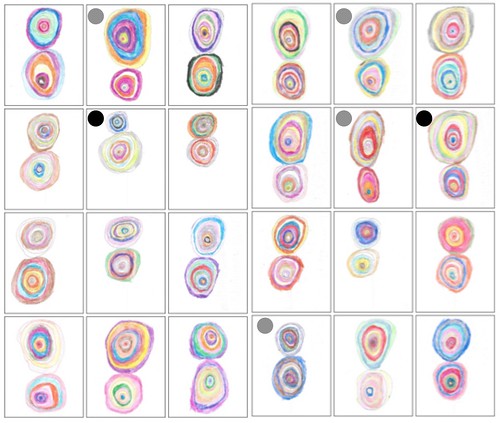
I’ve consolidated my posts about the art of Jamie Bérubé into a single document with the title Jamie’s Investigations: The Art of a Young Man with Down Syndrome. You can download it at the usual places:
Academica.edu: https://www.academia.edu/29195347/Jamie_s_Investigations_The_Art_of_a_Young_Man_with_Down_Syndrome
Abstract, table of contents, and introduction are below.
* * * * *
Abstract
Jamie Bérubé is a young man with Down syndrome in his early twenties; he has been drawing abstract art since he was eleven. So far he has explored five types of imagery: 1) fields of colored dots in a roughly rectangular array, 2) tall slender towers with brightly colored horizontal ‘cells’, 3) pairs of concentric colored bands with one pair of concentrics above the other, 4) colored letterforms above a set of colored concentric bands, and 5) arrangements of fairly complex biomorphic forms. Taken together types 1&2 exhibit one approach to the problem of composing a page: place a large number of small objects on the page in a regular array. Types 3&4 exhibit a different approach: position relatively large objects in the center of the page. In some ways Bérubé’s fifth approach, arrangements of biomorphic objects, can be considered a synthesis of the two other approaches. Moreover the individual objects appear life-like and their arrangement on the page is dynamic, properties not otherwise evident in Bérubé’s art. It is his most recent form of art and may be considered the product of long-term experimentation.
CONTENTS
About Jamie Bérubé and His Art 2
Emergence: Jamie Discovers Art 3
On Discovering Jamie’s Principle 9
Scintillating Rhythm: Towers of Color 14
Composition: Concentrics and Letterforms 21
What We Have Discovered? 39
Jamie’s Evolution (so far) 39
Biomorphic Complexity 40
Color, Eye Movement, and Composition 42
About Jamie Bérubé and His Art
This is about the art of Jamie Bérubé, who has Down syndrome. He is the son of Michael Bérubé, who has just published a book about him: Life as Jamie Knows It: An Exceptional Child Grows Up (Beacon Press, 2016). Michael–I can call him that, as he is a friend–wanted to include a generous selection of Jamie’s art in the book, but, as you know, color reproduction is expensive. Instead, he put it online . I took a look, became fascinated, and decided to write a series of posts about it.
Jamie has settled on a few themes and motifs and has covered countless sheets of paper with them. He has no interest in figurative art; all his work is abstract. I suspect that is because the relationship between what you see on the page, as an artist, and what you do as you draw is quite direct in the case of abstract art, but oddly remote for figurative art.
I suspect that is because the relationship between what you see on the page, as an artist, and what you do as you draw is quite direct in the case of abstract art, but oddly remote for figurative art. While natural scenes often have a complexity that is easily avoided in abstract imagery, that is not, I suspect, the primary problem. The primary problem is that the world exists in three dimensions while drawing surfaces have only two dimensions. Figuring out how to project the 3D world into a 2D surface is difficult, so difficult that artists have at times taken to mechanical means, such as the camera obscura, a pinhole device used to project a scene onto a flat surface where the artist can then simply trace the image. Some years ago David Hockney caused a minor scandal in the art world when he suggested that the some of the old masters used mechanical aids, such as the camera obscura, rather than drawing guided only by the unaided eye.
But that’s a digression. The point is simply that figuring out how to place a line on a flat surface so that it accurately traces the outline of what one sees, that is a very difficult thing to do, so difficult that many artistic traditions have simply ignored the problem. By choosing to work only with abstract imagery, Jamie sidesteps that problem. He has chosen to work with round dots, concentric bands, rectangular towers and cells, and intriguingly biomorphic geometric objects. While that is a limitation, we should note that many fine artists have opted for abstraction over the last century and that a major family of aesthetic traditions, those is many Islamic nations, have eschewed representational art (as sacrilegious) and developed rich traditions of calligraphy and geometric patterning.
Jamie has chosen materials he is comfortable with and has thrived from doing so. What of others with Down syndrome? The late Judith Scott had Down syndrome and she achieved international acclaim as a fiber artist. Michael informs me, however, that he doesn’t know of anyone else with Down syndrome who draws as extensively as Jamie does. Is Jamie’s level of artistic skill that rare among those with Down syndrome? I certainly have no way of knowing.
What would happen if children with Down syndrome were exposed to Jamie’s art, perhaps even watch him doing it (most likely through video or film)? Would they imitate him and develop their own preferred motifs and themes? Could people be trained to teach the Jamie method?
All of these are terrific. They could be adapted beautifully to textiles -- fabric, rugs, pillows, etc. The biomorphs remind me of Keith Haring, although more elegant. Congratulations to Jamie!
ReplyDelete